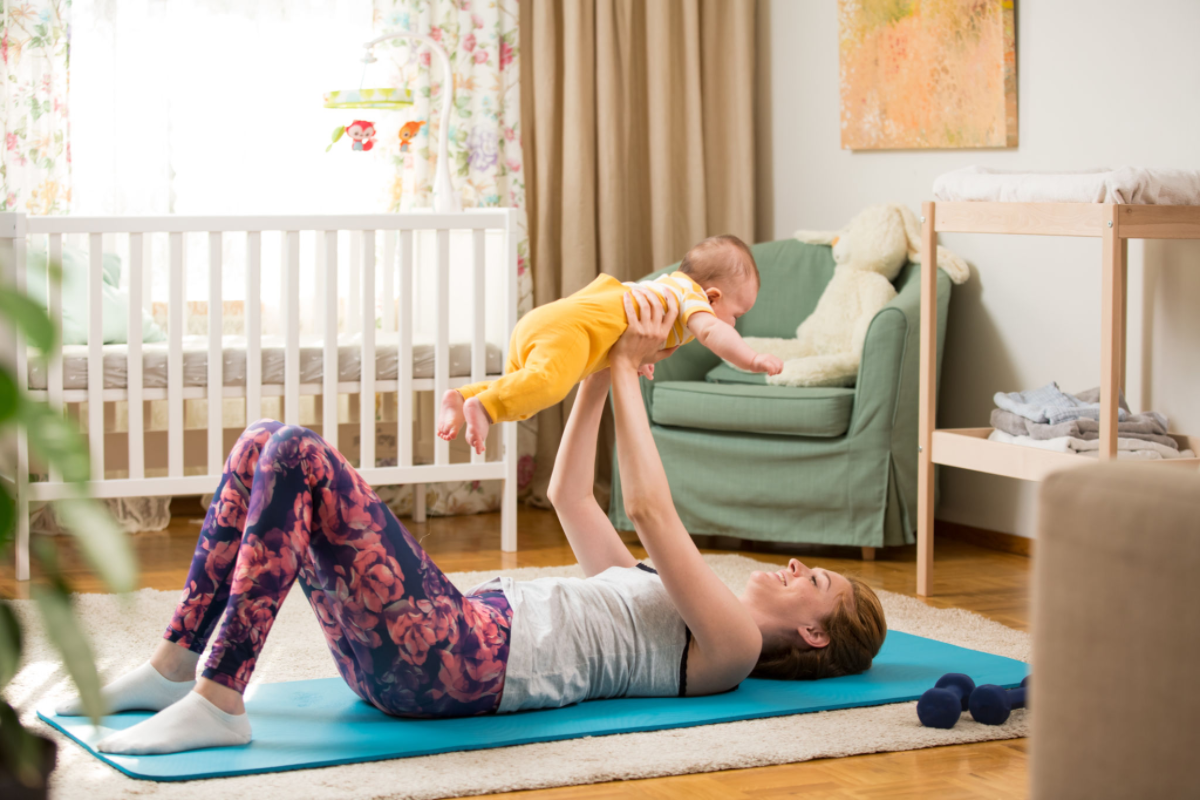Welcome, new moms, to the extraordinary adventure of motherhood! As you navigate this transformative experience, Motherhood Center in Houston, Texas, stands by your side, offering invaluable guidance on the intricacies of postpartum exercise. With over two decades of dedication to families, we understand the unique needs of new moms, and we’re here to help you embark on a fitness journey that nurtures both your physical and mental well-being.
In this guide, we’ll explore the importance of gradual postpartum exercise, acknowledging the changes your body undergoes during and after pregnancy. Motherhood Center, a trusted resource, is committed to empowering you on your post-baby fitness journey. Whether you’re eager to regain pre-pregnancy fitness levels or simply looking to incorporate movement into your daily routine, we’re here to provide practical insights and support tailored to your unique circumstances.
Join us as we discuss the physical and hormonal changes postpartum, the appropriate time to reintroduce exercise, and the types of workouts that are both safe and beneficial. Motherhood Center is your ally in fostering a holistic approach to postpartum well-being. Let’s embark on this empowering journey together, discovering the joys and benefits of postpartum exercise designed just for you.
Understanding Your Body Postpartum
After the beautiful journey of pregnancy and childbirth, your body undergoes remarkable changes. Understanding these changes is crucial as you embark on your postpartum fitness adventure. At Motherhood Center, we recognize the importance of comprehending the postpartum body to tailor your exercise routine for optimal well-being.
Physical Changes After Pregnancy
Your body experiences a multitude of physical transformations during and after pregnancy. From changes in weight distribution to muscle tone and skin elasticity, each aspect plays a role in shaping your postpartum physique. Abdominal muscles, in particular, may undergo separation during pregnancy, a condition known as diastasis recti. Recognizing these changes allows you to approach postpartum exercise with awareness and care.
Hormonal Influences on Postpartum Exercise
Hormonal fluctuations are a significant aspect of the postpartum period, influencing both physical and emotional well-being. The levels of estrogen and progesterone, which surged during pregnancy, now undergo a gradual decline. This hormonal shift can impact energy levels, mood, and muscle recovery. Understanding these influences empowers you to choose exercises that align with your body’s current state, fostering a positive and effective postpartum fitness routine.
Listening to Your Body’s Signals
Perhaps the most crucial aspect of postpartum exercise is tuning in to your body’s signals. Every woman’s journey is unique, and listening to what your body needs is key to a safe and fulfilling fitness routine. Whether it’s recognizing fatigue, understanding the difference between discomfort and pain, or acknowledging the need for rest, attuning yourself to these signals ensures that your postpartum exercise plan is not only effective but also sustainable. Motherhood Center is here to support you in this mindful approach, helping you build a postpartum fitness routine that celebrates and honors the incredible strength of your body.
When to Start Postpartum Exercise
Embarking on your postpartum exercise journey requires careful consideration of when to reintroduce physical activity into your routine. At Motherhood Center, we emphasize the importance of patience and a gradual approach, ensuring your body is ready for the challenges of exercise after childbirth.
Clearance from Healthcare Professionals
Before diving into postpartum exercise, it’s essential to obtain clearance from your healthcare professionals. Your body undergoes a unique healing process, and the guidance of your healthcare team ensures that you initiate exercise at the right time for your individual recovery. Postpartum check-ups provide an opportunity to discuss your fitness aspirations, allowing your healthcare provider to offer personalized advice tailored to your health and well-being.
Recognizing Individual Recovery Timelines
Every woman’s postpartum recovery timeline is distinct. Factors such as the type of delivery, overall health, and any complications during pregnancy contribute to the variability in recovery periods. Understanding and respecting your body’s timeline is crucial. We encourage you to approach postpartum exercise with patience, acknowledging that the journey to physical activity may differ for each new mom.
Signs Your Body Is Ready for Exercise
Your body communicates its readiness for exercise through various signals. Feeling strong, having improved energy levels, and experiencing reduced postpartum discomfort are positive indicators. However, it’s vital to be attuned to these signs without rushing the process. Motherhood Center advocates for a gentle and gradual reintroduction to exercise, focusing on movements that align with your body’s readiness. By recognizing these signs and incorporating expert advice, you can embark on a postpartum fitness routine that enhances your overall well-being.
Safe Postpartum Exercises
Ensuring a safe and effective postpartum exercise routine is paramount as you embrace the path to fitness after childbirth. At Motherhood Center, we advocate for exercises that prioritize your well-being while accommodating the unique needs of the postpartum body.
Gentle Cardiovascular Workouts
Begin your postpartum fitness journey with gentle cardiovascular exercises that promote heart health without straining your body. Low-impact activities like brisk walking, swimming, or stationary cycling are excellent choices. These exercises enhance circulation, boost energy levels, and lay the foundation for more intensive workouts as your body continues to recover.
Strength Training for Postpartum Bodies
Incorporating strength training into your routine helps rebuild muscle tone and supports overall body strength. Focus on exercises that target major muscle groups, utilizing body weight or light resistance. Motherhood Center offers specialized strength training programs designed for postpartum bodies, emphasizing proper form and gradual progression.
Postpartum Yoga and its Benefits
Yoga is a gentle yet powerful option for postpartum exercise, promoting flexibility, relaxation, and mindful movement. At Motherhood Center, our Mom and Baby Yoga classes provide a nurturing environment for new moms to connect with their bodies and bond with their infants. These classes combine gentle yoga poses with baby-friendly activities, creating a supportive community for postpartum wellness.
Low-Impact Activities for New Moms
Low-impact activities, such as Pilates or barre workouts, are ideal for new moms seeking a balance between strength and flexibility. These exercises focus on controlled movements, reducing stress on joints and minimizing the risk of injury. Motherhood Center offers a range of low-impact classes tailored to postpartum needs, providing a supportive space for moms to rebuild strength and confidence.
Incorporating these safe and mindful postpartum exercises into your routine, along with joining our Mom and Baby Yoga classes, allows you to embark on a fitness journey that nurtures both your physical and emotional well-being. Motherhood Center is committed to supporting you every step of the way as you navigate the joys of postpartum exercise.
Exercises to Avoid Initially
Embarking on a postpartum exercise routine is an exciting step toward recovery and vitality, but it’s crucial to navigate this journey with care. Certain activities, while beneficial in the long run, may pose risks during the initial phases of recovery. Motherhood Center places a strong emphasis on caution, offering guidance on exercises to avoid to ensure the safety and well-being of new moms.
High-Impact Cardio and Its Risks
In the early postpartum period, it’s advisable to steer clear of high-impact cardiovascular exercises, such as running or jumping, as they can strain still-recovering pelvic muscles and joints. These activities may lead to discomfort and potential injury. It’s recommended to delay high-impact exercises until you receive clearance from your healthcare provider and ensure your body is ready for more intense activity.
Intense Abdominal Exercises
While core strength is essential, engaging in intense abdominal exercises too soon after childbirth can strain the abdominal muscles and potentially worsen diastasis recti—a separation of the abdominal muscles. Activities like full sit-ups or double-leg lifts should be avoided during the initial postpartum phase. Instead, focus on gentler core exercises that promote healing without placing undue stress on the abdominal area.
Heavy Lifting Concerns
Weightlifting, especially heavy lifting, can strain the pelvic floor and abdominal muscles during the early stages of postpartum recovery. It’s advisable to avoid lifting heavy weights until core strength is rebuilt and approval is received from healthcare providers. Opt for lighter weights and gradually progress as your body becomes more resilient.
Impact on Pelvic Floor Health
Activities and exercises that place excessive pressure on the pelvic floor, such as certain yoga poses or heavy lifting, may compromise pelvic floor health. Maintaining the integrity of the pelvic floor is crucial for overall well-being. Incorporating pelvic floor exercises into your routine and gradually introducing activities that support, rather than strain, this essential muscle group, is key to a mindful and informed postpartum recovery.
By being aware of exercises to avoid initially and adopting a gradual and cautious approach, you can prioritize your postpartum recovery while laying the foundation for a safe and effective fitness journey.
Building a Postpartum Exercise Routine
As you progress through the postpartum period, building a thoughtful and gradual exercise routine becomes a cornerstone of your well-being journey. Motherhood Center understands the importance of this phase, emphasizing the significance of a tailored approach that aligns with your unique recovery and fitness goals.
Gradual Progression and Patience
The crux of a successful postpartum exercise routine lies in the principles of gradual progression and unwavering patience. Starting with low-impact exercises and gradually intensifying as your body strengthens is paramount. Every woman’s postpartum journey is distinct, and embracing a patient approach is essential. By doing so, you establish the groundwork for a sustainable and effective fitness routine.
Incorporating Pelvic Floor Exercises
Integral to any postpartum exercise routine is the inclusion of pelvic floor exercises. Beyond contributing to muscle strength, these exercises play a vital role in overall health. Seeking guidance on incorporating pelvic floor exercises into your routine ensures their inclusion. Strengthening the pelvic floor is not only beneficial for fitness but also holds significance in postpartum recovery and overall well-being.
Balancing Cardio and Strength Training
A well-rounded postpartum exercise routine encompasses a harmonious blend of cardiovascular workouts and strength training. Insights into finding the right balance help in designing a routine that addresses both cardiovascular health and muscle strength. Whether opting for gentle walks, postpartum-friendly yoga, or specialized strength training sessions, achieving equilibrium tailored to your body’s needs is key to a holistic postpartum fitness journey.
Addressing Mental Health Through Exercise
Recognizing the significance of mental health in the postpartum journey, Motherhood Center emphasizes the pivotal role of exercise in nurturing emotional well-being.
The Role of Exercise in Postpartum Depression Prevention
Exercise is a powerful tool in preventing and alleviating postpartum depression. Regular physical activity releases endorphins, the body’s natural mood elevators, promoting a positive mental state. Motherhood Center encourages viewing exercise not only as a means to enhance physical health but also as a crucial ally in managing and preventing postpartum depression. However, if you experience severe symptoms, seeking professional help is paramount.
Finding Joy in Movement for Emotional Well-being
Incorporating joyful and mindful movement into your routine can profoundly impact emotional well-being. Whether through a leisurely stroll, a dance session, or a yoga class, engaging in activities that bring joy can alleviate stress, reduce anxiety, and enhance overall mood. Finding forms of exercise that resonate personally, transforms each session into a positive and uplifting experience.
Incorporating Social Elements into Fitness
Postpartum exercise also provides an opportunity to foster social connections, a vital component of mental health. Joining group classes or exercising with friends creates a supportive environment, reducing feelings of isolation and promoting a sense of community. Motherhood Center encourages exploring fitness activities, such as the classes we offer, with a social dimension, creating a space where shared experiences contribute to overall mental well-being.
By acknowledging the link between exercise and mental health, and incorporating mindful and joyful movement into your routine, you enhance not only your physical well-being but also cultivate a positive and resilient mindset. Motherhood Center is here to support you in embracing the holistic benefits of postpartum exercise for your mental health and overall happiness.
Postpartum Exercise and Breastfeeding
Balancing postpartum exercise with breastfeeding requires thoughtful consideration, ensuring the well-being of both mother and baby. Understanding the connection between postpartum fitness and breastfeeding is essential for a harmonious and healthy integration during this transformative period.
Nutritional Considerations for Active Breastfeeding Moms
Breastfeeding mothers engaging in postpartum exercise must pay close attention to their nutritional needs. The increased energy demands of breastfeeding necessitate additional caloric intake to support both maternal recovery and the production of nourishing breast milk. Adequate hydration is equally vital, emphasizing the importance of replenishing fluids lost during exercise. For specialized nutritional advice and support, consider exploring breastfeeding resources and classes at Motherhood Center.
Timing Exercise Sessions Around Feeding
Strategically planning exercise sessions around feeding schedules is crucial for breastfeeding moms. Working out after breastfeeding can help alleviate discomfort and prevent engorgement, ensuring that your baby receives nourishment without potential disruptions caused by post-exercise changes in milk composition.
Ensuring Hydration During Workouts
Maintaining proper hydration during workouts is essential for both mother and baby. Breastfeeding already increases fluid requirements, and exercise intensifies the need for adequate hydration. Motherhood Center emphasizes the importance of staying well-hydrated, offering breastfeeding resources and classes to provide insights into water intake before, during, and after exercise. These resources ensure that your postpartum fitness journey aligns seamlessly with your breastfeeding goals.
Conclusion: Embracing Your Postpartum Wellness Journey
As you navigate the intricate landscape of postpartum exercise, it’s vital to embrace a holistic approach that prioritizes both your physical and mental well-being. Understanding the changes your body undergoes postpartum, recognizing the safe and effective exercises, and acknowledging the profound link between exercise and mental health are key elements in this transformative journey.
In crafting a postpartum exercise routine, remember the importance of gradual progression, incorporating pelvic floor exercises, and striking a balance between cardiovascular workouts and strength training. These considerations lay the foundation for a sustainable and empowering fitness journey.
Moreover, addressing mental health through exercise becomes a cornerstone of postpartum well-being. The joy found in movement, the social connections forged through fitness, and the role of exercise in preventing postpartum depression underscore the profound impact physical activity can have on your emotional health.
For those navigating postpartum exercise while breastfeeding, understanding nutritional considerations, timing exercise sessions around feedings, and ensuring proper hydration are essential components. Consider exploring specialized resources and classes, such as those offered at Motherhood Center, to receive personalized guidance and support tailored to your unique postpartum experience.
If you’re ready to take the next step in your postpartum wellness journey, we invite you to contact Motherhood Center. Explore the array of postpartum fitness classes, including Mom and Baby Yoga, designed to nurture your body and mind. Additionally, discover other invaluable services, such as breastfeeding classes, massage services, postpartum doula support, childcare services, and virtual classes for those unable to attend in person. Your journey to postpartum well-being awaits—contact Motherhood Center to embark on a path that celebrates and supports every aspect of your motherhood experience.
FAQs
When is it safe to start postpartum exercise after giving birth?
It’s crucial to obtain clearance from your healthcare provider before starting postpartum exercise. Typically, for uncomplicated deliveries, light activities like walking can begin soon after birth. However, more intensive exercises should wait until after your postpartum check-up, usually around six weeks.
What types of exercises are safe during the postpartum period?
Gentle activities such as walking, swimming, and postpartum-friendly yoga are excellent choices. Low-impact exercises like pelvic floor exercises and light strength training can also be beneficial. Always listen to your body and progress gradually.
Is it safe to engage in postpartum exercise while recovering from a cesarean section?
Yes, but it’s essential to follow your healthcare provider’s guidance. Start with gentle movements like walking and pelvic floor exercises once you receive clearance, usually around six weeks postpartum. Gradually introduce more activities, avoiding high-impact exercises initially. Consider specialized postpartum exercise programs and classes for tailored support during recovery. Always prioritize your comfort and well-being.
Can postpartum exercise help prevent postpartum depression?
Yes, regular exercise has been shown to play a significant role in preventing and alleviating postpartum depression. Physical activity releases endorphins, contributing to a positive mental state. It’s an integral part of your holistic well-being.
How can I find the right balance between postpartum exercise and self-care?
Balancing postpartum exercise with self-care involves gradual progression, listening to your body, and finding joy in movement. Explore classes like Mom and Baby Yoga for a supportive community. Contact Motherhood Center for information on personalized fitness classes, breastfeeding resources, and a range of services designed for your postpartum journey.






